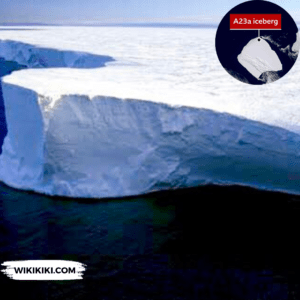The iceberg A23a the largest in the world has finally broken free from its three-decade-long anchorage to the ocean floor in the Weddell Sea. This block of ice measuring 4,000 sq km (1,500 sq miles) more than twice the size of Greater London, had initially split from the Antarctic coastline in 1986. However, it quickly became grounded, earning itself the status of an ice island. After 30 years of immobility.

Also Read: Richest 1% Emit More Carbon than Poorest Two-Thirds, Oxfam Report
A23a’s size is with a thickness of approximately 400m (1,312 ft), surpassing structures like the London Shard.
Originating from the outbreak of icebergs from the Filchner Ice Shelf in Antarctica, A23a’s calving coincided with a Soviet research station situated on the White Continent in 1986. The urgency to retrieve equipment from the Druzhnaya 1 base due to the iceberg’s detachment.
Dr. Andrew Fleming a remote sensing expert from the British Antarctic Survey, suggests that the consensus among experts is that the time had simply come for A23a to decrease in size sufficiently to lose its grip and start moving.
Although there was speculation about changes in shelf water temperatures, the view is that this colossal iceberg was destined to stir from its lengthy slumber. Dr. Fleming first detected signs of movement in 2020, marking the beginning of A23a’s journey.
Recent months have witnessed a noticeable acceleration in A23a’s movement driven by winds and currents.
As it passes the northern tip of the Antarctic Peninsula, it is poised to enter the Antarctic Circumpolar Current, setting it on a trajectory known as iceberg alley.
This is the same route exploited by the legendary explorer Sir Ernest Shackleton in 1916 to escape Antarctica following the loss of his ship, the Endurance.
Also Read: Dominican Republic Floods Leave At Least 21 Dead
Shackleton’s route led to South Georgia, an island frequently visited by large tabular icebergs like A23a. However, the shallow continental shelf around South Georgia poses challenges, as icebergs have a tendency to get pinned in these waters.
Scientists are closely monitoring A23a’s progress recognizing the environmental impact of its movements. If the iceberg grounds at South Georgia, home to millions of seals, penguins, and seabirds, it could disrupt normal foraging routes and impede the ability of these creatures to feed their young adequately.
While the prospect of icebergs causing disruption is not new, with incidents like iceberg B09B impacting penguin colonies, the A23a’s journey lies in its colossal size for the ecosystems of South Georgia.
There is a growing acknowledgment of their importance in the wider environment. As icebergs like A23a melt, they release mineral dust incorporated during their formation in glaciers scraping along the rock bed of Antarctica.
This dust serves as a source of nutrients for organisms forming the base of ocean food chains. Dr. Catherine Walker from the Woods Hole Oceanographic Institution addresses the life-giving nature of these icebergs, that they are the origin point for an amount of biological activity in the oceans.
Also Read: Delhi AQI: Air Quality Continues to be in “Severe” Category
The recent satellite image of A-76A, another massive iceberg, entering the Drake Passage and heading towards its eventual demise underlines the cyclical nature of iceberg existence.
A-76A, measuring 84 miles long and 16 miles wide, is part of the larger A-76 iceberg that broke off from the Ronne Ice Shelf in May 2021.
The Drake Passage, known for its strong ocean currents, is expected to carry A-76A away from Antarctica, contributing to its gradual melting.
Climate change has accelerated the calving of icebergs from ice shelves, contributing to rising sea levels. Understanding the relationship between climate change, ocean currents, and iceberg behavior is for predicting future trends and their implications for coastal regions and marine ecosystems.
A-76A, the largest fragment of the previous record-holder A-76, recently entered the Drake Passage on its journey toward demise.
The colossal size and slow melt of these icebergs challenge their behavior and they play in regulating ocean temperatures and supporting marine life.
Also Read: Philippines: Mindanao Region a Felt 6.9 Magnitude Earthquake
/cloudfront-us-east-2.images.arcpublishing.com/reuters/T7COBHTLVJLY5L6ARMLECQQ2PU.jpg)




